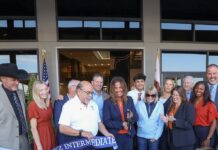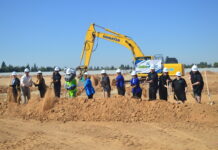 After almost two months of California’s shut down of all non-essential business, Gov. Gavin Newsom is giving the green light for some businesses to reopen as the state moves into phase two of its four-stage reopening plan.
After almost two months of California’s shut down of all non-essential business, Gov. Gavin Newsom is giving the green light for some businesses to reopen as the state moves into phase two of its four-stage reopening plan.
Phase two begins Friday, May, 8 and allows businesses in the retail and manufacturing sectors to reopen throughout the state, as long as they abide by Newsom’s social distancing and health safety guidelines.
Newsom said in a media briefing May 7 that the retail businesses allowed to reopen include clothing, sporting goods, music, book and toy stores, as well as florists. Under his guidelines, retail stores are required to do curb-side pick-up, although there are reports of retail stores in more rural areas, including Clovis, that are opening their doors to customers while implementing social distancing measures.
The state requires all reopening retailers to create a plan to protect workers and customers from COVID-19. The plan includes outlining sanitation and social distancing protocols, training employees on how to limit the spread of COVID-19 and having measures in place to screen employees for respiratory illness on a daily basis.
The state is providing an outline of the plan online.
State officials also recommend that retail businesses implement a “hands free” approach to ways that customers can pay and shop.
As far as manufacturing, state officials recommend that manufactures and warehouses close indoor break areas and provide employees with sanitation materials and personal protective equipment.
“We know that we’re going to gradually reopen California only as we can reduce the risk to all Californians from contracting COVID-19,” Dr. Mark Ghaly, the state’s secretary of Health and Human Services, said during the May 7 briefing.
While Newsom confirmed the aforementioned sectors had the go-ahead to open, it is worth noting that the state has yet to release a clear and detailed list of specific businesses that are allowed to reopen.
What is clear is that businesses including offices, dine-in restaurants, bars and shopping malls – while included in the phase two reopening in state documents – still do not have Newsom’s permission to reopen. However, Newsom said earlier this week that he expects to reopen those businesses in the coming weeks.
Other sectors may have to wait months before receiving the go-ahead from the state.
Work spaces designated by the state as “high risk” will have to wait until stage three, which Newsom previously said is likely months away. Those businesses include salons, barbershops, gyms, sports without live audiences, movie theaters and in-person religious services.
Some sectors, including concerts, festivals, convention center events and live audience sports, will not be able to reopen until stage four, which Newsom said would not happen until a vaccine is available or immunity is reached.
California’s detailed four stage reopening plan can be found on the state’s website.
Some of the businesses not included in stage two may still reopen in Clovis, as the city said Monday, May 4, that it would only enforce the state’s order in the event of an extreme violation. Those businesses may still face backlash from the state, however.
You can read more about the city’s decision to lift its emergency orders and what it means for local businesses here.
Clovis was hit particularly hard by the shutdown.
Mayor Drew Bessinger said the city had an unemployment rate of 3.2 percent before the crisis began. That number shot up to an estimated 15 percent as of this week, Bessinger said, with an estimated 31 percent loss of jobs.
“In Clovis, we were doing fairly well,” Bessinger said. “And we all got pushed off a cliff, unexpectedly.”
Clovis is not the only Central Valley community to lift its restrictions, as Visalia said it is lifting its restrictions and giving its local businesses the option to reopen.
Newsom also faces pressure from more rural California counties to speed up the state’s approach to reopening more businesses.
The governor has responded by giving counties the option to take a faster approach to reopening their businesses. In order to do so, county officials must submit a “containment plan” for how they will limit the spread of COVID-19. That means proving their counties have low COVID-19 case counts, that their health care facilities can handle a 35 percent surge in cases, and that they meet testing and contact tracing criteria.
The guidelines come with strict criteria, as counties hoping to qualify must have had no COVID-19-related deaths two weeks prior to submitting its plan and have less than one coronavirus case per 1,000 people.
Newsom said he will release more information on how counties can speed up their approach to reopening their economies on Tuesday, May 12.








